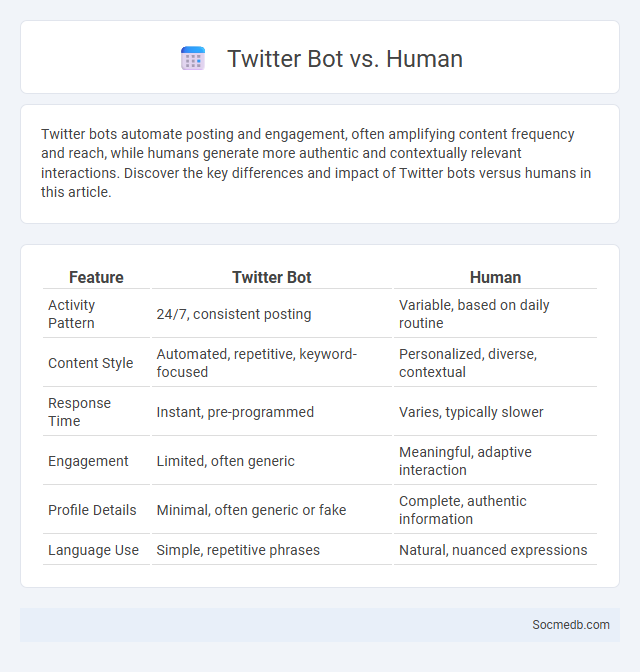
Photo illustration: Twitter Bot vs Human
Twitter bots automate posting and engagement, often amplifying content frequency and reach, while humans generate more authentic and contextually relevant interactions. Discover the key differences and impact of Twitter bots versus humans in this article.
Table of Comparison
| Feature | Twitter Bot | Human |
|---|---|---|
| Activity Pattern | 24/7, consistent posting | Variable, based on daily routine |
| Content Style | Automated, repetitive, keyword-focused | Personalized, diverse, contextual |
| Response Time | Instant, pre-programmed | Varies, typically slower |
| Engagement | Limited, often generic | Meaningful, adaptive interaction |
| Profile Details | Minimal, often generic or fake | Complete, authentic information |
| Language Use | Simple, repetitive phrases | Natural, nuanced expressions |
Introduction to Twitter Bots and Human Users
Twitter bots automate posting, liking, and following activities, enhancing engagement but sometimes spreading misinformation. Human users provide genuine interactions, creativity, and personalized responses that build authentic communities. Understanding the distinction between automated bots and real users is crucial for evaluating content credibility and social media dynamics.
Key Differences: Bots vs. Humans on Twitter
Bots on Twitter automate posts using predefined algorithms, often lacking nuanced human interaction and emotional intelligence. Humans engage through personalized content, responding with empathy and context, which fosters genuine connections and dynamic conversations. Unlike bots, human activity reflects variability in tone and timing, contributing to authentic social media engagement and community building.
Types of Twitter Bots and Their Functions
Twitter bots vary widely, including content generators that post tweets automatically based on algorithms or data feeds, and engagement bots that like, retweet, or follow users to boost visibility or influence trends. There are also spam bots designed to distribute unsolicited advertisements or phishing links, as well as news bots that disseminate updates from reliable sources in real time. Each type serves distinct purposes, from marketing enhancements to information dissemination or malicious activities, shaping the dynamics of social media interactions on the Twitter platform.
How Human Behavior Differs from Bots
Human behavior on social media displays nuanced emotional responses, unpredictable engagement patterns, and spontaneous interactions, contrasting sharply with bots' programmed, repetitive actions and uniform messaging. Your content strategy should account for these genuine social cues and varied reactions to foster authentic connections and community growth. Understanding these differences helps optimize user engagement metrics and target real audiences effectively.
Bot Detection: Techniques and Tools
Bot detection leverages advanced machine learning algorithms and behavioral analytics to identify automated accounts by analyzing patterns such as posting frequency, interaction types, and content similarity. Tools like Botometer and Socialbakers provide real-time insights by scanning network activities and user behaviors to distinguish genuine users from bots. Enhancing your social media strategy with these techniques ensures greater authenticity and protects your online community from spam and manipulation.
Social Impact of Bots versus Humans on Twitter
Bots on Twitter significantly amplify the spread of information, often creating echo chambers and influencing public opinion through automated retweets and replies. Human users contribute nuanced perspectives and authentic interactions, fostering genuine social engagement and community building. The interplay between bots and humans shapes public discourse, with bots sometimes skewing sentiment analysis and humans providing contextual understanding.
Bot vs. Human Engagement Patterns
Social media engagement patterns reveal distinct differences between bots and humans, with bots often posting at high frequencies and showing repetitive or non-contextual interactions. Human engagement typically includes varied timing, nuanced language, and interactive behaviors such as genuine comments and personalized responses. Analyzing metadata and interaction quality helps identify automated bot activity, improving platform integrity and user experience.
Ethical Concerns: Bots Operating as Humans
Bots operating as humans on social media platforms raise significant ethical concerns by distorting authentic user interactions and spreading misinformation. These automated accounts manipulate public opinion, create fake engagement, and erode trust in online communities. Protecting your digital experience requires awareness of these deceptive practices and advocating for stricter platform policies to ensure transparency and accountability.
Future Trends: Twitter Bots and Human Interaction
Emerging future trends in social media highlight the increasing role of Twitter bots in shaping online discourse, leveraging AI to simulate human interaction with high accuracy. These bots facilitate real-time content dissemination and user engagement, enhancing personalized information delivery while raising concerns about authenticity and manipulation. Advances in natural language processing and machine learning will further blur the lines between automated and genuine human communication on the platform.
Conclusion: Navigating a Bot-Human Twitter Ecosystem
Navigating a Twitter ecosystem populated by both bots and humans requires critical evaluation of content authenticity and source credibility. Your ability to discern algorithm-driven posts from genuine user interactions enhances the quality of information you consume and share. Emphasizing verified accounts and utilizing advanced filter tools can significantly reduce exposure to misleading or automated content.
 socmedb.com
socmedb.com